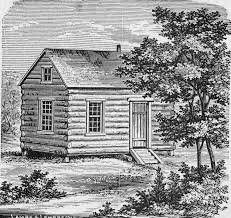The History of the Log Cabin
In the U.S., we associate log cabins with pioneer days; intrepid early Americans leaving their homes in the East or Europe to build a new life on the frontier. For many of us, the first image that comes to mind when we think of a log cabin is Little House on the Prairie.
The original log cabin designs were simple, as trees were the only building material, and the ax, adz, and auger were the only tools for construction.  The typical log cabin design was a small, one-room hut with one door and possibly one or more small windows. The logs were stacked and the spaces were filled with mud to keep out the wind and cold. There were no nails during this time, so the logs were fastened with notched ends, or with wooden pegs. For the roof, overlapping rows of short boards were used. The floor was hard packed clay and the window openings were covered with oiled paper to let in a little light. The home was heated with an open fireplace that also served as the cookstove.
The typical log cabin design was a small, one-room hut with one door and possibly one or more small windows. The logs were stacked and the spaces were filled with mud to keep out the wind and cold. There were no nails during this time, so the logs were fastened with notched ends, or with wooden pegs. For the roof, overlapping rows of short boards were used. The floor was hard packed clay and the window openings were covered with oiled paper to let in a little light. The home was heated with an open fireplace that also served as the cookstove.
Log cabins were also widely used in European countries like Germany, Switzerland, and the Scandinavian countries. In 1638 Swedish settlers built log cabins when they came to Delaware and other colonists followed their example. After the Revolution, a large number of settlers began to move westward and found thick forests in Tennessee, Kentucky, and the Northwest Territory, making the log cabin the standard home for backwoodsmen.
In 1840, log cabins gained notoriety and fame in the U.S. during the presidential campaign. Small log cabins were used in parades by William Henry Harrison to show his support of the frontier  people. Log cabins reached their peak complexity, however, during the mid-19th century with the Adirondack-style.
people. Log cabins reached their peak complexity, however, during the mid-19th century with the Adirondack-style.
Log cabin building never died out, but was surpassed by the needs of a growing urban country. During the 1930’s and the Great Depression, log cabins were built throughout the West for use by the Forest Service and the National Park Service under the Civilian Conservation Corps.
The modern version of a log cabin today is a log home, which is a house built typically with milled logs. These are mass manufactured with squared milled logs that are pre-cut for easy assembly.
Log homes are popular in rural areas and sometimes suburban and resort communities.  With today’s tools and technology, the log cabin has evolved from the original frontier model but today’s log homes still reflect the independent, adventurous spirit of the settlers who first built them.
With today’s tools and technology, the log cabin has evolved from the original frontier model but today’s log homes still reflect the independent, adventurous spirit of the settlers who first built them.
